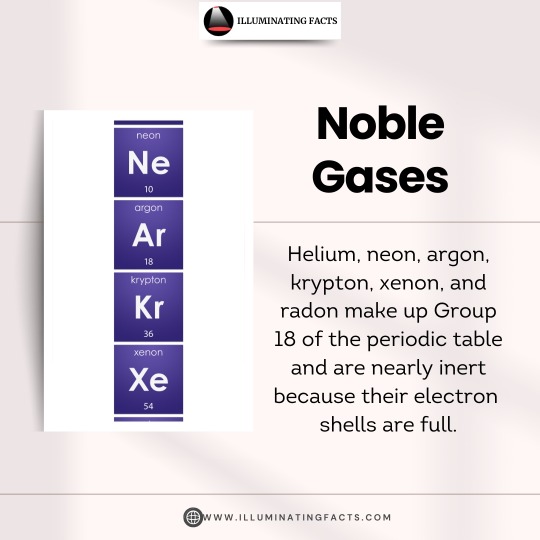#PeriodicTable
Explore tagged Tumblr posts
Text

Another bust drawing of one of Starsteel's professional warriors, Platinum!
Check out my comic, Element Eon!
#robot#originalcharacter#armor#armored#bust#metal#oc#periodictable#platinum#pt#scifi#shine#shiny#soldier#white#elementeon#original character#periodic table#sci fi#element eon
2 notes
·
View notes
Text

them :0
helium (the labling with wings) uses she/it and the alpha particle (hamster thing in her arms) is called alphius or alphy for short
please reblog my art (not forced of course), I want more people to see it
8 notes
·
View notes
Photo

Did you know? 🧪 Noble gases like helium, neon, and argon are nearly inert because their electron shells are full! ⚛️✨ Science at its most stable.
2 notes
·
View notes
Text
My favorite Element on the Periodic Table is number 99.
#99 on the periodic table= Einsteinium
Symbol= ES
Atomic #= 252
Discovered in= 1952
member of the actinide series
State at 20°C= Solid
Electron Configuration= [RN] 5f117s2
Block= F
Melting Point= 860°C / 1580°F
I have a weird hyperfixation on the Periodic Table. Idk I really like chemistry. I memorized this information because I just like the element, I like the element Einsteinium because I think the name is funny. ☠️
I think I need help or sum idk☠️☠️☠️
#periodic table of elements#periodic table#periodictable#my favorite element on the Periodic Table#PERIODIC TABLE FAVORITE ELEMENT#einsteinium#informative#informational#i think i need therapy#I think I need mental help#uh oh
10 notes
·
View notes
Text
Understanding Periodic Table

When people think about understanding periodic table, they usually focus on the big names like hydrogen, carbon, or oxygen. But if you take a closer look at the center of the table specifically Groups 5 to 8, you’ll find a set of powerful, underrated elements that play major roles in everyday life. These groups in understanding periodic table include strong, adaptable transition metals that contribute immensely to modern science and technology. From the iron in your blood to the tungsten in your lightbulb, these elements may not make headlines, but we depend on them every single day. Whether you’re a student, a science enthusiast, or just curious about how the world works, you’ll discover why Groups 5 to 8 deserve far more recognition. Group 5: Strong, Steady, and Super Useful Understanding periodic table in group 5 includes vanadium, niobium, tantalum, and dubnium. Though these metals rarely appear in casual conversations, industries like construction, electronics, and energy rely heavily on them. Engineers add vanadium to steel to make it stronger and lighter perfect for bridges, airplanes, and industrial tools. It also boosts the performance of vanadium redox flow batteries, which store renewable energy efficiently. Manufacturers use niobium and tantalum in electronics, especially in capacitors found in smartphones, laptops, and gaming consoles. Thanks to their resistance to heat and corrosion, these elements ensure technology lasts longer. Scientists created dubnium in the lab, and although it currently has no practical uses, researchers continue to study it to better understand the behavior of heavy elements. Group 6: The Heavy Hitters Chromium, molybdenum, tungsten, and seaborgium make up Group 6. These elements are famous for their strength, heat resistance, and adaptability. You’ve probably seen chromium in chrome finishes, but its main job lies in stainless steel, which resists rust and staining. Chromium compounds also color paints and dyes and help tan leather. Molybdenum strengthens high-performance steel and industrial tools. Biologically, it supports essential enzymes in both plants and animals. Tungsten, with the highest melting point of all metals, endures extreme heat. Industries use it in lightbulb filaments, rocket parts, and high-performance cutting tools. Like dubnium, seaborgium is a synthetic element with no direct applications. However, studying it helps scientists push the boundaries of atomic science. Group 7: Rare but Impactful Group 7 includes manganese, technetium, rhenium, and bohrium. While these names might not be widely known, each element plays a vital role. In trace amounts, manganese helps enzymes in the human body. Engineers add it to steel to enhance strength especially for buildings, railroads, and heavy machinery. Scientists first synthesized technetium in a lab. In medicine, technetium-99m is crucial for imaging organs like the heart and bones, helping doctors detect diseases early. Rhenium, one of the rarest elements, performs exceptionally well in jet engines and electronics because of its durability under extreme heat and pressure. Researchers created bohrium to explore the behavior of heavy, unstable elements. While it has no industrial use, it adds to our understanding of advanced nuclear science. Group 8: Iron And Its Relatives Iron, ruthenium, osmium, and hassium make up Group 8. These metals are reliable, strong, and essential to both life and technology. Humans have used iron for centuries to build tools, machines, and structures. In the body, iron enables red blood cells to carry oxygen. Because it’s cheap and abundant, it remains one of the most used elements on Earth. Ruthenium boosts the performance of computer chips and hard drives and acts as a catalyst in chemical reactions, speeding up industrial processes. Osmium, the densest naturally occurring element, appears in pen tips, electrical contacts, and precision tools. Scientists primarily study hassium in nuclear labs to expand our knowledge of atomic structure and behavior near the edge of the periodic table. Conclusion Understanding periodic table from Groups 5 to 8 may not attract as much attention as alkali metals or noble gases, but their contributions are far-reaching and deeply embedded in our daily lives. These transition metals support critical industries from construction and electronics to medicine and energy. Some elements give strength to skyscrapers, others power your devices, and a few help doctors diagnose illnesses. While several occur naturally, others were crafted in labs purely to push scientific boundaries. So next time you glance at the periodic table, take a moment to appreciate the central groups the strong, silent contributors keeping the world running behind the scenes. Read the full article
0 notes
Text
WBCHSE Classification Of Elements And Periodicity In Properties Question And Answers
#Chemistry#Science#ChemicalReactions#PeriodicTable#MolecularScience#ClassificationOfElementsAndPeriodicityInPropertiesQuestionAndAnswers
0 notes
Text
Helium Gas Market Opportunity Analysis & Industry Forecast, 2024–2030
Helium Gas Market Overview

Request Sample:
The growing need for helium in lifting applications, food packaging and the burgeoning electronics markets adds to its demand. Additionally, innovations in helium recovery and recycling, alongside strategic stockpiling by nations, emphasize its significance in ensuring supply chain security amidst resource constraints. The growing investments in helium exploration also drives the market by addressing supply challenges, supporting diverse applications, and ensuring long-term stability.
A notable trend in the helium gas market is the growing interest in space exploration. This reflects humanity’s pursuit of technological innovation, cosmic discovery and potential new resources. In March 2024, Japan launched a multibillion-dollar Space Strategic Fund aimed at supporting the Japan Aerospace Exploration Agency (JAXA). The $6.7 billion fund, approved for a decade-long period, will facilitate the development, technology demonstration and commercialization of cutting-edge space technologies, driving significant growth in the country’s space sector. Helium hard drives are HDDs sealed with helium instead of air, leveraging helium’s low density to reduce turbulence and friction, allowing for thinner platters, increased capacity (up to 10 platters), improved performance, energy efficiency, cooler operation, reduced noise and enhanced reliability. Helium HDDs are vital in large-scale data centers for efficient storage.
Market Snapshot :
Helium Gas Market — Report Coverage:
The “Helium Gas Market Report — Forecast (2024–2030)” by IndustryARC, covers an in-depth analysis of the following segments in the Helium Gas Market.
AttributeSegment
By Form
Liquified
Compressed
By Supply
Cylinders
Bulk and Micro Tanks
Drum
On-site
By Purity
High Purity Helium
Medium-Purity Helium
Industrial-Grade Helium
By Application
MRI Scanning
Welding and Metal Fabrication
Cryogenics
Lifting and Balloons
Leak Detection
Breathing Mixes
Pressurizing and Purging
Controlled Atmosphere Source
Others
By End-Use Industry
Healthcare
Electronics
Aerospace and Defence
Energy
Industrial Manufacturing
Others
By Geography
North America (U.S, Canada and Mexico)
Europe (Germany, France, UK, Italy, Spain, Netherlands, Belgium, Denmark and Rest of Europe)
Asia-Pacific (China, Japan, South Korea, India, Australia, New Zealand, Indonesia, Thailand, Malaysia and Rest of Asia-Pacific)
South America (Brazil, Argentina, Chile, Colombia and Rest of South America)
Rest of the World (Middle East and Africa).
Inquiry Before Buying:
COVID-19 / Ukraine Crisis — Impact Analysis:
Initially, the COVID-19 pandemic caused a decrease in helium demand due to reduced industrial and medical activities during lockdowns. This temporarily alleviated the helium shortage by reducing consumption. However, as industries resumed operations, the demand surged, leading to a tighter supply and rising prices. Challenges in global logistics also disrupted the helium supply chain exacerbating shortages.
Russia, a major global supplier of helium, faced production and export restrictions due to the war. Facilities like the Amur Gas Processing Plant, critical to Russia’s helium production, experienced operational disruptions. European countries’ shift away from Russian natural gas further complicated helium extraction processes in regions like Algeria, which redirected its natural gas to pipelines instead of liquefying it to extract helium. These disruptions contributed to a major helium shortage in two decades increasing global supply constraints and driving up costs.
Key Takeaways
MRI Scanning is the Largest Segment by Application
Helium, specifically in its liquid state, is a cryogenic substance used to cool the superconducting magnets in MRI systems to extremely low temperatures (around -269°C or 4 Kelvin). These low temperatures are necessary for the magnets to achieve and sustain superconductivity, which is critical for generating the strong and stable magnetic fields required for high-resolution imaging. According to Collective Minds, the global volume of MRI scans continues to grow annually, with current estimates ranging from 100–150 million scans worldwide. The demand for helium in this sector is substantial, as MRI technology is widely used in medical diagnostics to visualize detailed internal structures of the human body, aiding in the detection and monitoring of diseases. As per the 2024 India Private Equity Report, healthcare investments in India hit a record high of $5.5 billion in 2023, driven by a threefold increase compared to 2022. Additionally, the growth of the healthcare sector, advancements in imaging technology and increasing prevalence of conditions requiring MRI diagnostics further bolster the helium demand.
Schedule A Call:
Medium Purity Helium is the Largest Segment
Medium Purity Helium (99.0% to 99.99%) is the largest segment in the helium market due to its widespread applications across various industries, driven by both its properties and cost-effectiveness. In the manufacturing sector, it is extensively used in welding for non-ferrous metals like aluminium and copper, where high-quality, stable inert gases are essential for precise, clean welding. The welding industry is growing primarily driven by the construction and automotive industry. According to the American Welding Society, the US will require more than 360,000 welders by 2027. In the cryogenic industry, medium purity helium is a key component in cooling systems for MRI machines, superconducting magnets and particle accelerators. The combination of its versatile properties, availability, and lower cost compared to higher-purity helium makes it a highly attractive option for industries that require a reliable and efficient gas.
North America Leads the Market
North America continues to dominate the global helium gas market, bolstered by its abundant natural helium reserves and advanced extraction and distribution infrastructure. The United States, in particular, holds significant helium resources in regions such as the LaBarge field in Wyoming and the Texas Panhandle, which are key sources for the global market. Additionally, several companies are now interested in the helium exploration business which contribute to cutting-edge production, liquefaction and distribution technologies. Additionally, the region’s strong industrial base and healthcare advancements ensure a steady and robust demand for helium across sectors such as cryogenics, healthcare, aerospace, and manufacturing. In September 2024, North American Helium’s 9th helium purification facility at Antelope Lake, Saskatchewan, became operational. The facility has a production capacity of approximately 50 MMcf/year, increasing the company’s total capacity to 210 MMcf/year. NAH has reached a US $ 0.35 billion investment milestone in Saskatchewan, supported by government incentives such as the Critical Minerals Processing Investment Incentive (CMPII). Since launching its first facility in 2020, NAH, as of September 2024, produces ~7% of North America’s helium and aims for 20%.
Buy Now :
Limited Helium Reserves and Extraction Dependence to Hamper the Market

For more details on this report — Request for Sample
Key Market Players
Global Helium Gas top 10 companies include:
Air Liquide SA
Air Products and Chemicals, Inc.
Linde Plc
QatarEnergy LNG
Iwatani corporation
Messer Group
Nippon Sanso Holdings Corp
Matheson Tri-Gas Inc.
North American Helium (NAH)
Gazprom
By Form, By Supply, By Purity, By Application, By End-Use Industry and By Geography
Geographies Covered
North America (U.S., Canada and Mexico), Europe (Germany, France, UK, Italy, Spain, Netherlands, Belgium, Denmark and Rest of Europe), Asia-Pacific (China, Japan, South Korea, India, Australia, New Zealand, Indonesia, Thailand, Malaysia and Rest of Asia-Pacific), South America (Brazil, Argentina, Chile, Colombia and Rest of South America), Rest of the World (Middle East and Africa)
Key Market Players
Air Liquide SA
Air Products and Chemicals, Inc.
Linde Plc
QatarEnergy LNG
Iwatani corporation
Messer Group
Nippon Sanso Holdings Corp
Matheson Tri-Gas Inc.
North American Helium (NAH)
Gazprom
For more Chemicals and Materials Market reports, please click here
0 notes
Text
Happy Periodic Table Day to everyone in the crowd and on http://FreezeCrowd.com today! What is a cool fact about the periodic table on your college campus? We appreciate this table, and you joining us with your Friday Feeling! ❤️😀❄️
1 note
·
View note
Photo






(via "Never Give Up Motivational Science Design STEM inspirational" Graphic T-Shirt for Sale by w1ckerman)
0 notes
Text
Reading Adventures!
In October, I read four books:
From Pompeii by Ingrid Rowland
This book was four stars for me. I enjoyed it, except for one very long chapter full of some objectionable material. I do love history, and natural disasters are fascinating. I learned a lot in this book, and was interested to note all the famous people that visited Pompeii at one point or another.
Mendeleyev's Dream by Paul Strathern
Meh. This book was 3.5 stars for me. I felt the author had an obvious bias that was very annoying. The teaser at the beginning and then the long detour into the entire history of chemistry was unexpected and not entirely welcome. I did get some laughs out of it, though, with some funny quotes from famous chemists.
Valiant Ambition by Nathaniel Philbrick
I loved this book. 5 stars. I almost always rate history books very highly, because I love history so much. This book follows Benedict Arnold during the early years of the Revolutionary War, and shows us his frustrations with Congress and his slow slide toward betrayal. I learned a lot. I didn't know much about him beyond his attempted betrayal of West Point. It was very amusing to learn that he was either dearly loved or bitterly hated, no in between.
The Enigma Girls by Candace Fleming
4 stars. I liked this book a lot. I love to learn about codes and ciphers. This book follows five different young ladies and their roles during World War 2 in code breaking and intelligence. I did not know about this particular bit of history before, and I read practically the entire book in one sitting. This book is written for a younger audience, but that won't take away any enjoyment from older readers.
#books#octoberreads#history#pompeii#naturaldisaster#volcanoeruption#rome#archeology#chemistry#periodictable#revolutionarywar#earlyamericanhistory#benedictarnold#washington#worldwar2#femaleprotagonists#codesandciphers#codebreaking#englishcodebreakers
0 notes
Text
⚛️ Explore elements: Random Element Generator
0 notes
Text

A bust drawing for Cadmium!
Check out my comic, Element Eon!
#originalcharacter#bust#cadmium#colorful#cute#glasses#green#oc#orange#paint#periodictable#red#redhair#simple#slimegirl#woman#yellow#elementeon#original character#periodic table#red hair#slime girl#element eon
2 notes
·
View notes
Text

lablings in order of appearance: helium, ultraviolet, Quarks, boron
helium uses she/they, UV uses she/her, Quarks uses They/Them (capitalized cuz They are the labling's version of God), and boron uses he/him
#milo draws#lablings#ultraviolet ray#helium#boron#quarks#periodictable#periodic table of elements#electromagnetic spectrum#shitpost#milo's shitpastas
5 notes
·
View notes
Photo

Did you know? 🔬 There are 118 elements in the periodic table, and new elements are still being synthesized in labs! 🧪
#PeriodicTable#ScienceFacts#Elements#Chemistry#ScienceIsCool#PeriodicTableElements#STEM#ChemicalElements#ScienceExploration#LabExperiments#ScientificDiscovery
1 note
·
View note
Text










🌟 Discover the elements like never before! 🌿💎
Get ready to meet the periodic table in anime form—where each element is brought to life as a unique, fierce, and captivating character. From fiery Hydrogen to noble Gold, these digital art pieces fuse science and fantasy in a way you’ve never imagined. 🔥✨
Which element girl is your favorite? Let me know in the comments! 💬👇
#DigitalArt#AnimeArt#PeriodicTable#ArtSeries#ElementalArt#AnimeStyle#CharacterDesign#MangaArt#FantasyArt#CreativeConcepts
0 notes
Text
WBCHSE Class 11 Physics For Simple Harmonic Motion: Definition, Examples
#Chemistry#Science#ChemicalReactions#PeriodicTable#MolecularScience#SimpleHarmonicMotionDefinitionExamples
0 notes